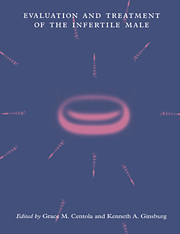Book contents
- Frontmatter
- Contents
- Preface
- List of contributors
- 1 Andrology
- 2 Sperm–egg interaction
- 3 Routine semen analysis
- 4 Computer-aided sperm analysis: a critical review
- 5 Antisperm antibodies: diagnosis and treatment
- 6 The sperm penetration assay
- 7 Intrauterine insemination for male factor
- 8 Processing human semen for insemination: comparison of methods
- 9 New assays for evaluating sperm function
- 10 Assisted reproductive technology for male factor infertility
- 11 Microinjection techniques for male infertility
- 12 Therapeutic donor insemination: screening, indications and technique
- 13 Endocrine assessment and hormone treatment of the infertile male
- 14 The urologic evaluation of the infertile male
- 15 Azoospermia: the diagnosis and treatment
- 16 White blood cells in semen and their impact on fertility
- 17 Psychological aspects of male infertility: lifting the shroud of shame
- 18 Evaluation of the female partner
- Index
11 - Microinjection techniques for male infertility
Published online by Cambridge University Press: 16 September 2009
- Frontmatter
- Contents
- Preface
- List of contributors
- 1 Andrology
- 2 Sperm–egg interaction
- 3 Routine semen analysis
- 4 Computer-aided sperm analysis: a critical review
- 5 Antisperm antibodies: diagnosis and treatment
- 6 The sperm penetration assay
- 7 Intrauterine insemination for male factor
- 8 Processing human semen for insemination: comparison of methods
- 9 New assays for evaluating sperm function
- 10 Assisted reproductive technology for male factor infertility
- 11 Microinjection techniques for male infertility
- 12 Therapeutic donor insemination: screening, indications and technique
- 13 Endocrine assessment and hormone treatment of the infertile male
- 14 The urologic evaluation of the infertile male
- 15 Azoospermia: the diagnosis and treatment
- 16 White blood cells in semen and their impact on fertility
- 17 Psychological aspects of male infertility: lifting the shroud of shame
- 18 Evaluation of the female partner
- Index
Summary
Introduction
Male factor infertility affects 25–50% of the couples presenting for evaluation and therapy (Glass, 1991). Depending upon semen quality and the underlying pathophysiologic diagnosis, some of these patients become candidates for assisted fertilization. Our aim in this chapter is to assist the reader in helping patients make decisions as to what method should be used to treat their fertility problem. Although this guidance is based upon scientific data from the literature it is important that the practitioner maintain a sensitive, thorough approach to the couple when dealing with emotional, religious, ethical and financial concerns which may arise during evaluation and treatment.
In vitro fertilization (IVF) increases sperm exposure to the female gamete. Strategies that improve sperm–oocyte exposure have included altering sperm concentration and enhancing motility. For example, in teratozoospermic samples when the incubate was increased from 50 000 motile sperm to between 500 000 and 1 million motile sperm per milliliter per oocyte, fertilization rates of 75% were reported (Oehninger et al., 1988a). Using a simple wash and swim-up technique, the morphology and motion parameters of the sperm exposed to the oocytes can be significantly improved (Oehninger et al., 1990). Even though the fertilization and implantation success reported was excellent, there were increased numbers of spontaneous miscarriages and low term pregnancy rates (Oehninger et al., 1988a).
In addition to the above, oocyte micromanipulation can assist male-factor couples. In cases of low sperm count consideration may be given to oocyte micromanipulation for assisted fertilization. Table 11.1 indicates criteria which may be helpful in selecting patients or micromanipulation (World Health Organization, 1987; Kruger et al., 1988; Acosta, 1992; Coddington et al., 1993a).
- Type
- Chapter
- Information
- Evaluation and Treatment of the Infertile Male , pp. 156 - 170Publisher: Cambridge University PressPrint publication year: 1996



